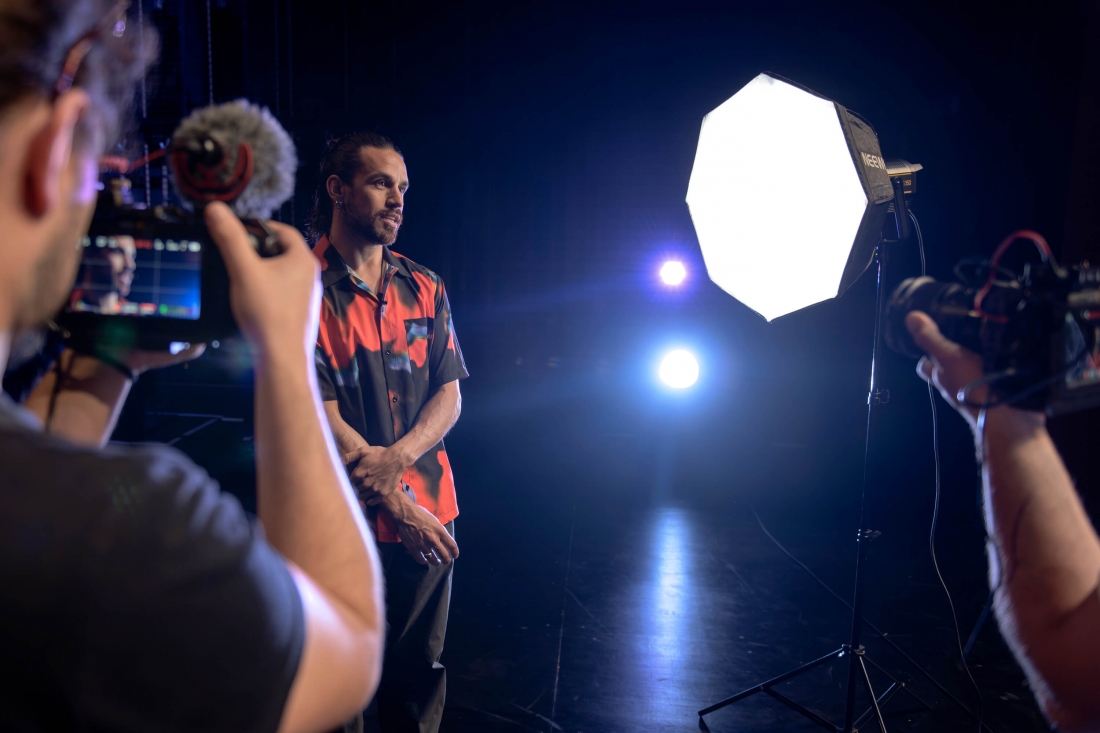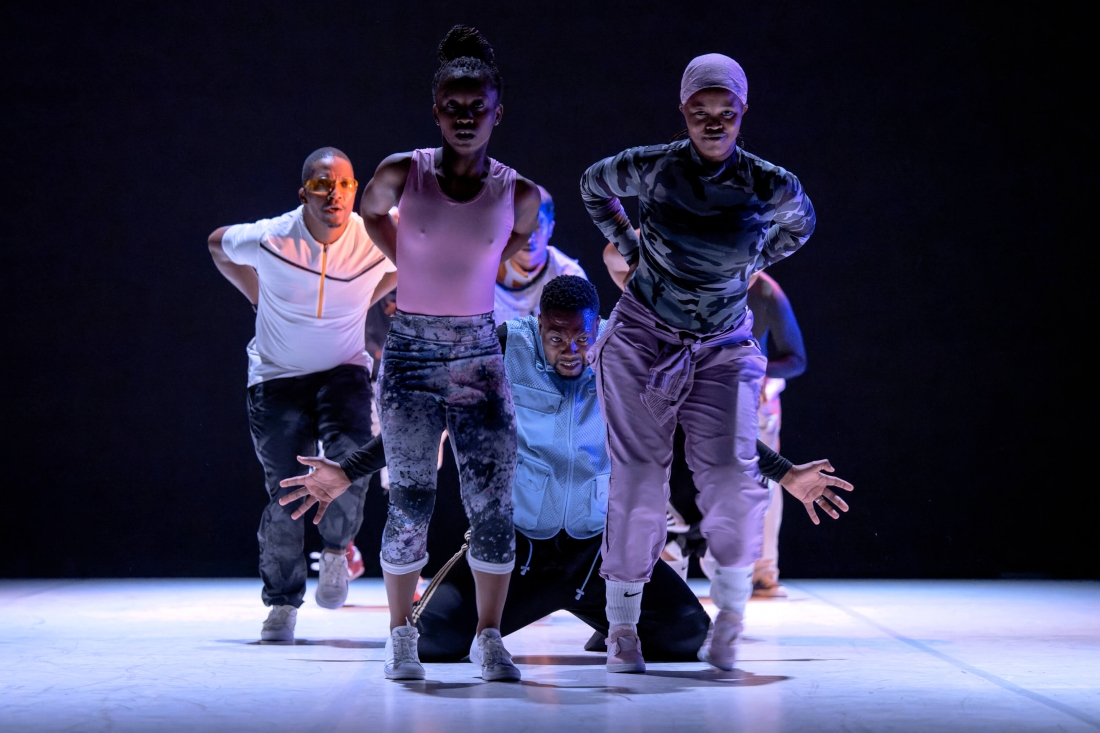Interview
Marco da Silva Ferreira
September
2022
Tue
6
On the 16th and 17th of September, the presentation of Via Injabulo by the South African dance company Via Katlehong opens the TMP’s 22/23 season. During their residency, in June, at Campo Alegre, we talked with Marco da Silva Ferreira about førms Inførms (one of the two pieces that are part of the show).
How did Via Katlehong's invitation come about? Have you ever worked or knew the company's work? How is the process of creating førms Inførms going?
Last year, I received the invitation to choreograph Via Katlehong Dance Company, from Katlehong, which is close to Johannesburg. After several conversations with their agent and their company director, we finally accepted the invitation. I worked in South Africa between January and March, and then took a break. Now, in June, here we are again, in Porto, for our last technical residency, and we're going straight to Amsterdam to premiere.
Dance is a fundamental element for the construction of a collective identity. How would you describe the importance of pantsula in the South African social context?
This company has as its basic technique or practice pantsula, a style of dance that emerged in the black communities of South Africa, specifically in the townships, built in Apartheid precisely to house and separate the black community from the white community. Of course, this is a dance that arises in a social context, which is a biopolitical engine, which is a sociopolitical engine. Therefore, it is impossible to dissociate that this dance arose in this context. What does it come to? It comes as an answer to several things: a complaint of happiness, of freedom, of community, of meaning of belonging, of being together, of empowerment. It's a foot dance, very rich, very fast, very urgent, very lively. And full of staccato and cuts, almost as if the body was always trying to find new ways to configure itself. This was the way I read it and I decided to transpose a little to this work.
In addition to the pantsula, there is a cross with dances of African-American origin (popping, house), clubbing...
I've never done pantsula before nor had any direct contact with it. Although I’ve seen a lot of videos and documentaries. Suddenly, in the afrohouse clubbing scene, the pantsula had become a huge reference. And I'm very close to the dances that exist in clubbing, specifically house, which emerged in the 80's in New York City. At that time, house was already fusioning the traditional Afrodescendant dances with salsa, tap dancing, Fred Astaire and some other more American references. Of course that, over the years, these links to afro and diaspora origins have become more present because the internet and globalization have arrived very quickly. Suddenly, the references travel much faster than before and pantsula went into the lexicon of clubbing, house and amapiano (which is the basis of pantsula).
In afrohouse, we have the kuduro, pantsula and many other styles, depending on the region or country where it comes from. And also specific musical genres, ways of dressing and interaction contexts. But all of them come together on clubbing.
How did you cross these references and styles with the dancers’ own cultural elements?
The pantsula is a very sharp and fast dance. And that for me was very important and interesting to explore. I wanted to understand what its urgency and its mood – because it is a dance with a lot of humour – and why it was so sharp; why the shapes were also so sharp and the body shattered itself so many times, reassembling after it.
So, I felt myself very close to this idea of bodies that are trying to reassemble, being able of dismantling and finding themselves a new shape again. The speed in relation with urgency, quickness, excitement, or even a demand for some happiness, liberation and euphoria - because it is difficult to live in a township. The access is difficult: there’s a lot of people living together, it's not fast, it's not practical. So, dance could naturally be an escape. In this piece, førms Inførms, I take the exact shape of pantsula and start from there to let it show me what it is. There is a Black collective that comes to a space and decides to occupy and open it to breathe; to make anything breathe. They decide to take this place and transform it, as a group, and through its cultural elements. Of course, I used Pantsula but I also used my own dance references. I used the composition, colors and dynamics to enhance a fiction, a poetry that can be very explicit (if we want to see it in very literal way) - and can be very poetic also because it is a bit timeless.
How did Via Katlehong's invitation come about? Have you ever worked or knew the company's work? How is the process of creating førms Inførms going?
Last year, I received the invitation to choreograph Via Katlehong Dance Company, from Katlehong, which is close to Johannesburg. After several conversations with their agent and their company director, we finally accepted the invitation. I worked in South Africa between January and March, and then took a break. Now, in June, here we are again, in Porto, for our last technical residency, and we're going straight to Amsterdam to premiere.
Dance is a fundamental element for the construction of a collective identity. How would you describe the importance of pantsula in the South African social context?
This company has as its basic technique or practice pantsula, a style of dance that emerged in the black communities of South Africa, specifically in the townships, built in Apartheid precisely to house and separate the black community from the white community. Of course, this is a dance that arises in a social context, which is a biopolitical engine, which is a sociopolitical engine. Therefore, it is impossible to dissociate that this dance arose in this context. What does it come to? It comes as an answer to several things: a complaint of happiness, of freedom, of community, of meaning of belonging, of being together, of empowerment. It's a foot dance, very rich, very fast, very urgent, very lively. And full of staccato and cuts, almost as if the body was always trying to find new ways to configure itself. This was the way I read it and I decided to transpose a little to this work.
In addition to the pantsula, there is a cross with dances of African-American origin (popping, house), clubbing...
I've never done pantsula before nor had any direct contact with it. Although I’ve seen a lot of videos and documentaries. Suddenly, in the afrohouse clubbing scene, the pantsula had become a huge reference. And I'm very close to the dances that exist in clubbing, specifically house, which emerged in the 80's in New York City. At that time, house was already fusioning the traditional Afrodescendant dances with salsa, tap dancing, Fred Astaire and some other more American references. Of course that, over the years, these links to afro and diaspora origins have become more present because the internet and globalization have arrived very quickly. Suddenly, the references travel much faster than before and pantsula went into the lexicon of clubbing, house and amapiano (which is the basis of pantsula).
In afrohouse, we have the kuduro, pantsula and many other styles, depending on the region or country where it comes from. And also specific musical genres, ways of dressing and interaction contexts. But all of them come together on clubbing.
How did you cross these references and styles with the dancers’ own cultural elements?
The pantsula is a very sharp and fast dance. And that for me was very important and interesting to explore. I wanted to understand what its urgency and its mood – because it is a dance with a lot of humour – and why it was so sharp; why the shapes were also so sharp and the body shattered itself so many times, reassembling after it.
So, I felt myself very close to this idea of bodies that are trying to reassemble, being able of dismantling and finding themselves a new shape again. The speed in relation with urgency, quickness, excitement, or even a demand for some happiness, liberation and euphoria - because it is difficult to live in a township. The access is difficult: there’s a lot of people living together, it's not fast, it's not practical. So, dance could naturally be an escape. In this piece, førms Inførms, I take the exact shape of pantsula and start from there to let it show me what it is. There is a Black collective that comes to a space and decides to occupy and open it to breathe; to make anything breathe. They decide to take this place and transform it, as a group, and through its cultural elements. Of course, I used Pantsula but I also used my own dance references. I used the composition, colors and dynamics to enhance a fiction, a poetry that can be very explicit (if we want to see it in very literal way) - and can be very poetic also because it is a bit timeless.




